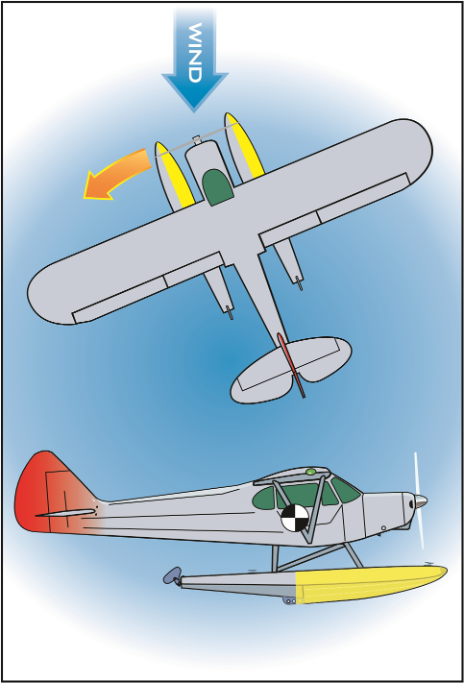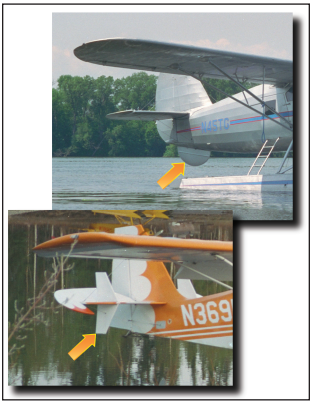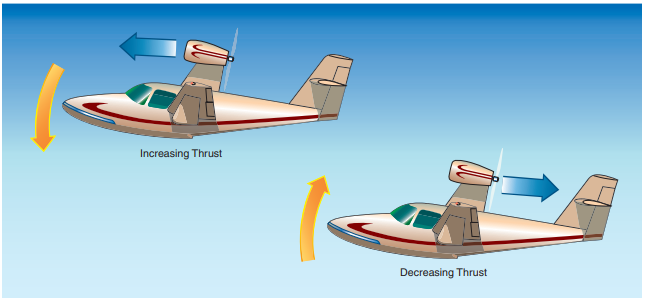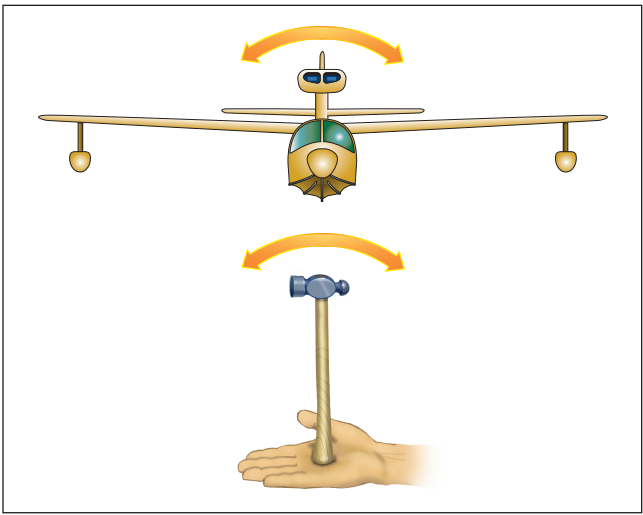PERFORMANCE CONSIDERATIONS FOR TAKEOFF, CLIMB, CRUISE, AND LANDING
Since many pilots are accustomed to a certain level of performance from a specific make and model of land airplane, the changes in performance when that same airplane is equipped with floats can lead to trouble for a careless or complacent pilot. Floats weigh somewhat more than the wheeled landing gear they replace, but floats are designed to produce aerodynamic lift to offset some of the weight penalty. Generating lift inevitably creates induced drag, which imposes a small reduction in overall performance. By far the greatest impact on performance comes from the parasitic drag of the floats.
TAKEOFF
In a landplane, takeoff distance increases with additional takeoff weight for two reasons: it takes longer for the engine and propeller to accelerate the greater mass to lift-off speed, and the lift-off speed itself is higher because the wings must move faster to produce the extra lift required. For seaplanes, there are two more factors, both due to water drag. As seaplane weight increases, the floats sink deeper into the water, creating more drag during initial acceleration. As with the landplane, the seaplane must also accelerate to a higher airspeed to generate more lift, but the seaplane must overcome significantly more water drag force as speed increases. This extra drag reduces the rate of acceleration and results in a longer takeoff run.
Naturally, the location of the additional weight within the seaplane affects center of gravity (CG) location.
Because of the way the floats respond to weight, the CG location affects the seaplane’s handling characteristics on the water. If the CG is too far aft, it may be impossible to put the seaplane on the step. If the CG is located to one side of the centerline, one float will be pushed deeper into the water, resulting in more water drag on that side. Be sure to balance the fuel load between left and right wing tanks, and pay attention to how baggage or cargo is secured, so that the weight is distributed somewhat evenly from side to side. [Figure 5-1]

Figure 5-1. The location of the CG can affect seaplane handling.
The importance to weight and balance of pumping out the float compartments should be obvious. Water weighs 8.34 pounds per gallon, or a little over 62 pounds per cubic foot. Performance decreases whenever the wings and engine have to lift and carry useless water in a float compartment. Even a relatively small amount of water in one of the front or rear float compartments could place the airplane well outside of CG limits and seriously affect stability and control.
Naturally, water also moves around in response to changes in attitude, and the sloshing of water in the floats can create substantial CG changes as the seaplane is brought onto the step or rotated into a climb attitude.
Some pilots use float compartments near the CG to stow iced fish or game from hunting expeditions. It is imperative to adhere to the manufacturer’s weight and balance limitations and to include the weight and moment of float compartment contents in weight and balance calculations.
Density altitude is a very important factor in seaplane takeoff performance. High altitudes, high tempera-tures, high humidity, and even low barometric pressure can combine to rob the engine and propeller of thrust and the wings of lift. Seaplane pilots are encouraged to occasionally simulate high density altitude by using a reduced power setting for takeoff. This exercise should only be attempted where there is plenty of water area, as the takeoff run will be much longer.
An experienced seaplane instructor can assist with choosing an appropriate power setting and demonstrating proper technique.
CLIMB AND CRUISE
When comparing the performance of an airplane with wheels to the same airplane equipped with floats, the drag and weight penalty of the floats usually results in a reduced climb rate for any given weight. Likewise, cruise speeds will usually be a little lower for a particular power setting. This in turn means increased fuel consumption and reduced range. Unless the airplane was originally configured as a seaplane, the performance and flight planning information for a landplane converted to floats will typically be found in the Supplements section rather than the Performance section of the Airplane Flight Manual (AFM) or Pilot’s Operating Handbook (POH).
In addition to working within the limits of the seaplane’s range, the pilot planning a cross-country flight must also consider the relative scarcity of refueling facilities for seaplanes. Amphibians have access to land airports, of course, but seaplanes without wheels need to find water landing facilities that also sell aviation fuel. While planning the trip, it is wise to call ahead to verify that the facilities have fuel and will be open at the intended arrival times. The Seaplane Pilots Association publishes a Water Landing Directory that is very helpful in planning cross-country flights.
In flight, the seaplane handles very much like the corresponding landplane. On many floatplanes, the floats decrease directional stability to some extent. The floats typically have more vertical surface area ahead of the airplane’s CG than behind it. If the floats remain aligned with the airflow, this causes no problems, but if the airplane begins to yaw or skid, this vertical area acts somewhat like a large control surface that tends to increase the yaw, making the skid worse. [Figure 5-2] Additional vertical surface well behind the CG can counteract the yaw force created by the front of the floats, so many floatplanes have an auxiliary fin attached to the bottom of the tail, or small vertical surfaces added to the horizontal stabilizer. [Figure 5-3]
LANDING
Landplane pilots are trained to stay on the lookout for good places to land in an emergency, and to be able to plan a glide to a safe touchdown should the engine(s) fail. An airplane equipped with floats will usually have a steeper power-off glide than the same airplane with wheels. This means a higher rate of descent and a diminished glide range in the event of an engine failure, so the pilot should keep this in mind when spotting potential landing areas during cruising flight.
Seaplanes often permit more options in the event of an unplanned landing, since land can be used as well as water. While a water landing may seem like the only choice for a non-amphibious seaplane, a smooth landing on grass, dirt, or even a hard-surface runway usually causes very little damage to the floats or hull, and may frequently be the safer alternative.

Figure 5-2. The side area of the floats can decrease directional stability.

Figure 5-3. Vertical surfaces added to the tail help restore directional stability.
FLIGHT CHARACTERISTICS OF SEAPLANES WITH HIGH THRUST LINES
Many of the most common flying boat designs have the engine and propeller mounted well above the air- frame’s CG. This results in some unique handling characteristics. The piloting techniques necessary to fly these airplanes safely are not intuitive and must be learned. Any pilot transitioning to such an airplane is strongly urged to obtain additional training specific to that model of seaplane.
Designing a seaplane with the engine and propeller high above the water offers some important advan- tages. The propeller is out of the spray during takeoffs and landings, and more of the fuselage volume can be used for passengers and cargo. The pilot usually sits well forward of the wing, and enjoys an excellent view in almost every direction.
Pilots who fly typical light twins are familiar with what happens when one engine is producing power and the other is not. The airplane tends to yaw toward the dead engine. This happens because the thrust line is located some distance from the airplane’s CG. In some respects, this situation is similar to the single-engine seaplane with a high thrust line, except that the sea- plane flies on one engine all the time. When power is applied, the thrust tends to pitch the nose down, and as power is reduced, the nose tends to rise. [Figure 5-4] This is exactly the opposite of what most pilots are accustomed to. In typical airplanes, including most floatplanes, applying power raises the nose and initiates a climb.
The most extreme pitch force logically results from a sudden engine failure, when the full thrust of the engine and its associated downward pitching force are suddenly removed. Forward thrust is replaced by the drag of a windmilling propeller, which adds a new upward pitching force. Since the seaplane is already trimmed with a considerable elevator force to coun- teract the downward pitch force of the engine, the nose pitches up abruptly. If this scenario occurs just after takeoff, when the engine has been producing maximum power, airspeed is low, and there is little altitude, the pilot must react instantly to overpower the upward pitching forces and push the nose down to avoid a stall.
The reversal of typical pitch forces also comes into play if porpoising should begin during a takeoff. As discussed in Chapter 4, Seaplane Operations – Preflight and Takeoffs, porpoising usually occurs when the planing angle is held too low by the pilot, forcing the front portion of the floats to drag until a wave builds up and travels back along the float. The same thing can happen with the hull of a flying boat, and the nose-down force of a high thrust line can make porpoising more likely. Once porpoising develops, the standard solution is to reduce power and let the air- plane settle back into the water. But if power is reduced too quickly in a seaplane with a high-mounted engine, the sudden upward pitching force can combine with the porpoising to throw the seaplane into the air with inadequate airspeed for flight, decreasing thrust, and inadequate altitude for recovery.
Depending on how far the engine is from the airplane’s CG, the mass of the engine can have detrimental effects on roll stability. Some seaplanes have the engine mounted within the upper fuselage, while oth-

Figure 5-4. Pitching forces in seaplanes with a high thrust line.
ers have engines mounted on a pylon well above the main fuselage. If it is far from the CG, the engine can act like a weight at the end of a lever, and once started in motion it tends to continue in motion. Imagine balancing a hammer upright with the handle on the palm of the hand. [Figure 5-5]

Figure 5-5. Roll instability with a high-mounted engine.
Finally, seaplanes with high-mounted engines may have unusual spin characteristics and recovery techniques. These factors reinforce the point that pilots need to obtain thorough training from a qualified instructor in order to operate this type of seaplane safely.
MULTIENGINE SEAPLANES
A rating to fly single-engine seaplanes does not entitle a pilot to fly seaplanes with two or more engines. The addition of a multiengine sea rating to a pilot certificate requires considerable additional training. Dealing with engine failures and issues of asymmetrical thrust are important aspects in the operation of multiengine seaplanes.





